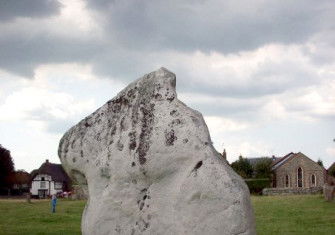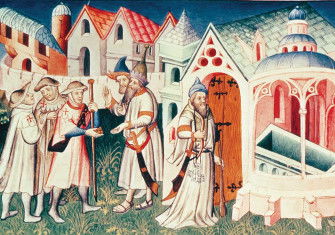‘The Bone Chests’ by Cat Jarman review
The Bone Chests: Unlocking the Secrets of the Anglo-Saxons by Cat Jarman is an enthusiastic guide through England’s early medieval past.

Beneath Winchester Cathedral, a faceless human figure silently oversees the rising waters that flood the crypt each winter. Installed in 1986 by the sculptor Antony Gormley, the statue invites the viewer to reflect on the contrast between the passing seasons and the permanence of a structure built nearly 1,000 years ago. ‘How’, Gormley asked, ‘do you make the timelessness of inert, silent objects count for something?’
The same question might well be asked of the six ornate mortuary chests resting on tall limestone screens on either side of the cathedral’s altar, far above the statue in the crypt below. The chests were traditionally believed to hold the remains of between nine and 11 people, all elite members of Anglo-Saxon or Anglo-Norman society. These range from Cynegils, the first Christian king of Wessex who died in the late seventh century, to William Rufus, king of England and son of William the Conqueror, who was killed by an ill-shot arrow some 450 years later. The Danish conqueror Cnut is thought to be in one of the chests, as is his influential wife Emma. Æthelwulf, father of King Alfred, may be also, as might Stigand, the deposed archbishop of Canterbury. In 2012, after sifting through approximately 1,300 bone fragments, researchers from the University of Bristol determined that there may in fact be as many as 23 people interred in the chests, not all of whom can be firmly identified. Perhaps most puzzling are the remains of two children between the ages of 10 and 15, of whom no record remains. In an age of carbon dating and DNA analysis, the very fact of the bones’ existence makes the early Middle Ages seem nearly within our grasp, yet the countless mysteries surrounding the chests remind us of how little we truly know of the world these people inhabited.
Bioarchaeologist Cat Jarman’s new book aims to bring at least a few of those interred in the Winchester Cathedral mortuary chests back to life. She does so via a multilayered narrative that traces both the history of the chests themselves and, more broadly, the evolution of Anglo-Saxon Wessex into the unified kingdom of England. As those familiar with this period know, she has rich material with which to work. In the words of the tenth-century chronicler Æthelweard, the story of early medieval England is one of ‘many wars and slayings of men and no small wreck of navies on the waves of the ocean’. Jarman’s book is not short on wars, slayings and shipwrecks, but it is equally a tale of political manoeuverings, clashes of culture, conflicts over gender and status – the larger trends that shaped early English society. Perhaps most of all, Jarman’s book is about the persistence of historical memory. The remains’ survival was by no means a foregone conclusion, particularly given the destructive consequences of the Norman Conquest, the Reformation and the English Civil War. The Winchester chests serve as a powerful testimony to how fragile history can be.
The Kingdom of Wessex was born sometime in the two centuries following the collapse of the Roman Empire, though the precise circumstances of its birth remain a mystery. Written sources for the period provide little in the way of detail, and it can be difficult to separate fact from myth and folk memory. The Anglo-Saxon Chronicle records that the first group of West Saxons arrived in Britain along with other tribes migrating from continental Europe in 449. In its entry for 519, the Chronicle first mentions that the West Saxons had established a kingdom for themselves, and by the time Cynegils assumed the throne in 611, the Chronicle had begun to refer to ‘the kingdom in Wessex’. A migratory tribe had become a place, a sovereign state with its own lands and borders.
The subsequent centuries witnessed the terror of the Viking invasions, the fall of the other early English kingdoms, the Alfredian revival, the establishment of a consolidated English kingdom under Æthelstan, its collapse under Æthelred, and its conquest, first by the Danish king Cnut and then by Duke William of Normandy. Readers of Jarman’s book will encounter a number of familiar faces – Alfred the Great, Edward the Confessor, Emma of Normandy and Saint Swithun among them – but equally compelling are the lives of lesser-known figures such as Bishop Wini, from whom Winchester gets its name, or the Danish turncoat Thorkell the Tall, whose soldiers martyred the saintly Archbishop Ælfeah of Canterbury. Jarman is an enthusiastic guide through England’s early medieval past; hers is an engaging tale engagingly told.
Yet Jarman’s story is as much about what happened to these people after death as it is about what they did before they met their (often untimely) ends. Most of those interred in the chests had initially been buried in the older seventh-century cathedral, but with its expansion in the tenth century and replacement with the current Norman building in the 12th, their remains had been exhumed and reburied so many times that the specific identity of each set of bones had been lost. In 1525, Bishop Richard Fox had the remains gathered up and placed in ten newly carved mortuary chests. Only six of the chests survived the depredations of the English Civil War. It is these that visitors see in the cathedral today.
Jarman is at her best when describing the advances in research that have made possible insight into the bones’ history. Even those already familiar with the history of medieval England will have much to learn from Jarman’s account of recent discoveries by geneticists, historians, archaeologists, biologists, archivists and scholars of early literature. In an increasingly ‘post-knowledge’ world, her book is eloquent testimony to the continuing necessity of historical research and the importance of ensuring that it remains adequately supported as an essential public good. So can the Winchester mortuary chests, like Antony Gormley’s sculpture, still act on us as living beings? Most emphatically, yes.
The Bone Chests: Unlocking the Secrets of the Anglo-Saxons
Cat Jarman
William Collins, 272pp, £25
Buy from bookshop.org (affiliate link)
Andrew Rabin is Professor and Vice Chair in the Department of English at the University of Louisville, Kentucky.






